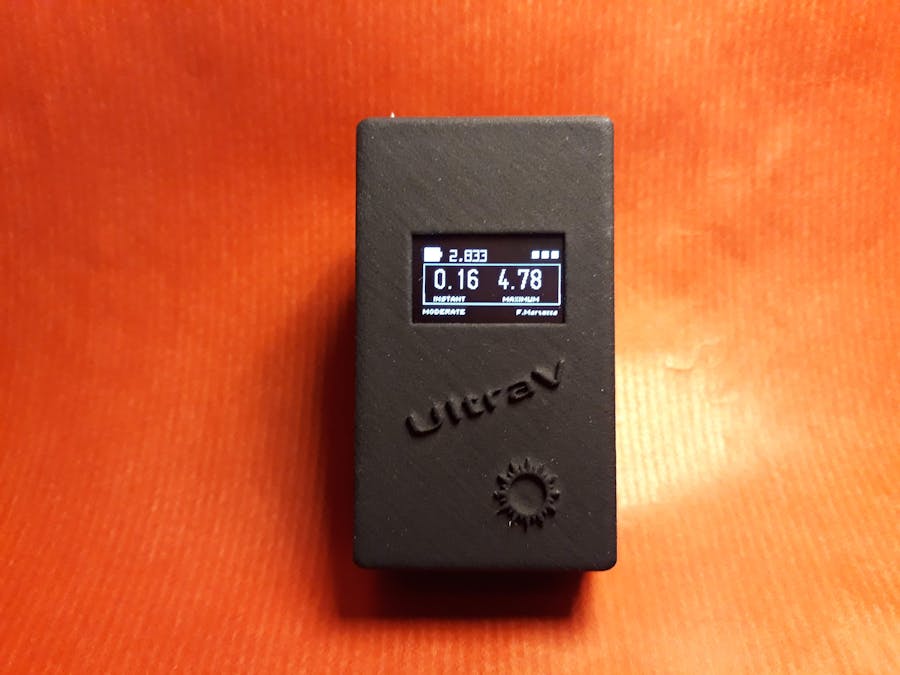Being unable to expose myself to the sun due to a dermatological problem, I used the time I would have spent on the beach to build an ultraviolet rays meter. UltraV.
It is built on an Arduino Nano rev3, with an UV sensor, a DC/DC converter to raise the 3v battery voltage, and a small OLED display. My main target was to keep it portable, so that I could easily know the UV-index in any moment and in any place.
Step 1: Parts and Components- Microcontroller Arduino Nano rev.3
- ML8511 UV sensor
- 128×64 OLED diplay (SSD1306)
- MT3608 DC-DC step-up
- CR2 battery
- CR2 battery holder
- Switch
- Enclosure case
The ML8511 (Lapis Semiconductors) is an UV sensor, which is suitable for acquiring UV intensity indoors or outdoors. The ML8511 is equipped with an internal amplifier, which converts photo-current to voltage depending on the UV intensity. This unique feature offers an easy interface to external circuits such as ADC. In the power down mode, typical standby current is 0.1µA, thus enabling a longer battery life.
Features:
- Photodiode sensitive to UV-A and UV-B
- Embedded operational amplifier
- Analog voltage output
- Low supply current (300µA typ.) and low standby current (0.1µA typ.)
- Small and thin surface mount package (4.0mm x 3.7mm x 0.73mm, 12-pin ceramic QFN)
Unfortunately, I didn’t have the chance to find any UV-transparent material to protect the sensor. Any kind of transparent cover I tested (plastic, glass, etc.) was attenuating the UV measurement. The better choice seems to be quartz fused silica glass, but I haven’t find any at a reasonable price, so I decided to leave the sensor outside the box, in open air.
Step 3: OperationsTo take a measure, just switch on the device and point it to the sun for several seconds, keeping it aligned with the direction of the sun rays. Then watch at the display: the index on the left always shows the instant measure (one each 200 ms), while the reading on the right is the maximum reading taken during this session: that’s the one you need.
In the lower left part of the display it is reported also the WHO equivalent nomenclature (LOW, MODERATE, HIGH, VERY HIGH, EXTREME) for the measured UV-index.
Step 4: Battery Voltage and ReadingI choose a CR2 battery, for its size and capacity (800 mAh). I used UltraV throughout the summer and the battery still reads 2.8 v, so I am quite satisfied of the choice. When operates, the circuit drains about 100 mA, but a reading measurement doesn’t take more than few seconds. As the battery nominal voltage is 3v, I added a DC-DC step up converter to bring the voltage up to 9 volts and connected it to the Vin pin.
In order to have the battery voltage indication on the display, I used an analog input (A2). Arduino analog inputs can be used to measure DC voltage between 0 and 5V, but this technique requires a calibration. To perform the calibration, you will need a multimeter. First power the circuit with your final battery (the CR2) and don’t use the USB power from the computer; measure the 5V on the Arduino from the regulator (found on the Arduino 5V pin): this voltage is used for the Arduino ADC reference voltage by default. Now put the measured value into the sketch as follows (suppose I read 5.023):
voltage = ((long)sum / (long)NUM_SAMPLES * 5023) / 1024.0;
In the sketch, I am taking the voltage measurement as an average over 10 samples.
Step 5: Schematic and ConnectionsFor the display, I used the U8g2lib which is very flexible and powerful for this kind of OLED displays, allowing a wide choice of fonts and good positioning functions.
Concerning the voltage reading from the ML8511, I used the 3.3v Arduino reference pin (accurate within 1%) as a base for the ADC converter. So, by doing an analog to digital conversion on the 3.3V pin (by connecting it to A1) and then comparing this reading against the reading from the sensor, we can extrapolate a true-to-life reading, no matter what VIN is (as long as it’s above 3.4V).
int uvLevel = averageAnalogRead(UVOUT);
int refLevel = averageAnalogRead(REF_3V3);
float outputVoltage = 3.3 / refLevel * uvLevel;
Download the full code from te following link.
Step 7: Enclosure CaseAfter several (bad) tests on manually cutting the rectangular display window on a commercial plastic box, I decided to design my own for it. So, with a CAD application I designed a box and to keep it as small as possible, I mounted the CR2 battery externally on the back side (with a battery holder glued on the box itself).
Download the STL file for the enclosure case, from the following link.
Step 8: Possible Future Improvements- Utilize an UV spectrometer to measure actual real-time UV-Index values under various conditions (UV spectrometers are very expensive);
- Simultaneously record output from the ML8511 with the Arduino microcontroller;
- Write algorithm to relate ML8511 output to actual UVI value in real-time under a wide range of atmospheric conditions.
- Carlos Orts: https://create.arduino.cc/projecthub/McOrts/mobil...
- Arduino forum: http://forum.arduino.cc/index.php?topic=3922.0
- Starting Electronics: https://startingelectronics.org/articles/arduino/...
- World Health Organization, UV Index: http://www.who.int/uv/intersunprogramme/activitie...













Comments